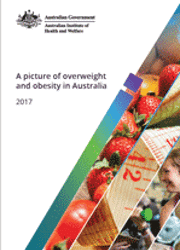Summary
Overweight and obesity is a major public health issue in Australia. It results from a sustained energy imbalance—when energy intake from eating and drinking is greater than energy expended through physical activity. This energy imbalance might be influenced by a person’s biological and genetic characteristics, and by lifestyle factors.
This report brings together a variety of information to create a picture of overweight and obesity in Australia. It summarises factors that influence people’s energy intake and expenditure and contribute to the rising prevalence of overweight and obesity, as well as some approaches aiming to reduce its prevalence. It presents the prevalence of overweight and obesity in children, adolescents, and adults, and includes trends over time, differences among population groups, and the health and economic impact of overweight and obesity.
One-quarter of children and adolescents are overweight or obese
In 2014–15, 1 in 5 (20%) children aged 2–4 were overweight or obese—11% were overweight but not obese, and 9% were obese.
About 1 in 4 (27%) children and adolescents aged 5–17 were overweight or obese—20% were overweight but not obese, and 7% were obese. For both children aged 2–4 and 5–17 years, similar proportions of girls and boys were obese.
For children aged 5–17, the prevalence of overweight and obesity rose from 21% in 1995 to 25% in 2007–08, then remained relatively stable to 2014–15.
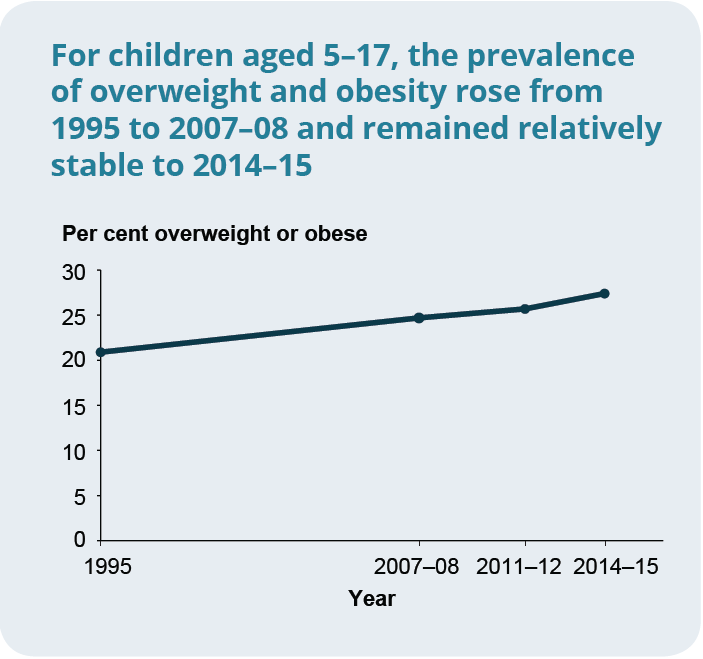
Nearly two-thirds of adults are overweight or obese, and obesity is on the rise
In 2014–15, nearly two-thirds (63%) of Australian adults were overweight or obese. The prevalence of overweight and obesity has steadily increased, up from 57% in 1995—which has largely been driven by a rise in obesity.
The prevalence of severe obesity among Australian adults has almost doubled over this period, from 5% in 1995 to 9% in 2014–15.
In 2014–15, 71% of men were overweight or obese, compared with 56% of women. A greater proportion of men (42%) than women (29%) were overweight but not obese, while a similar proportion of men (28%) and women (27%) were obese.
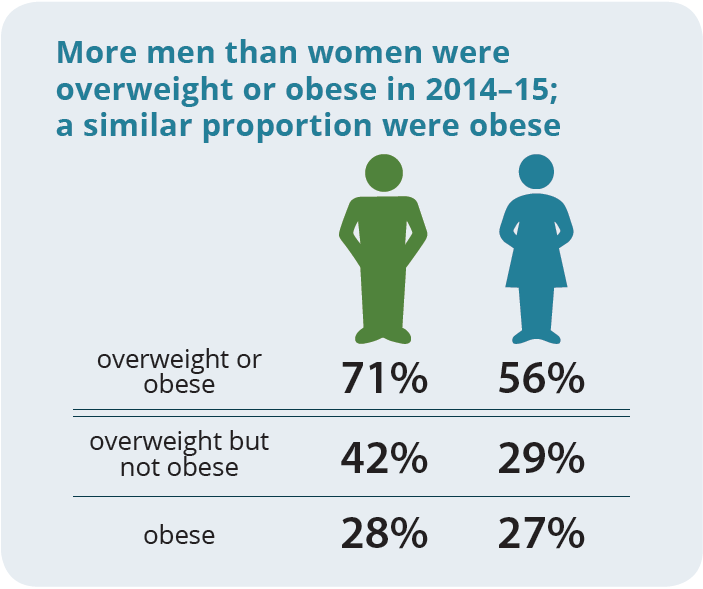
Some groups are more likely to be overweight or obese than others
Compared with non-Indigenous Australians, Indigenous adults are more likely to be overweight or obese, and Indigenous children and adolescents are more likely to be obese. Those who live outside of Major cities, or who are in the lower socioeconomic groups are more likely to be overweight or obese than others.
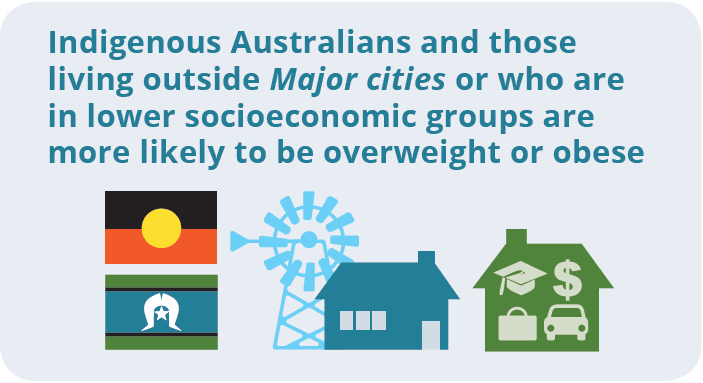
Overweight and obesity has high health and financial costs
Among adults, overweight and obesity has adverse health and economic impacts, including a higher risk of developing many chronic conditions, and of death (due to any cause).
Overweight and obesity was responsible for 7% of the total health burden in Australia in 2011, 63% of which was fatal burden. In 2011–12, obesity was estimated to have cost the Australian economy $8.6 billion.
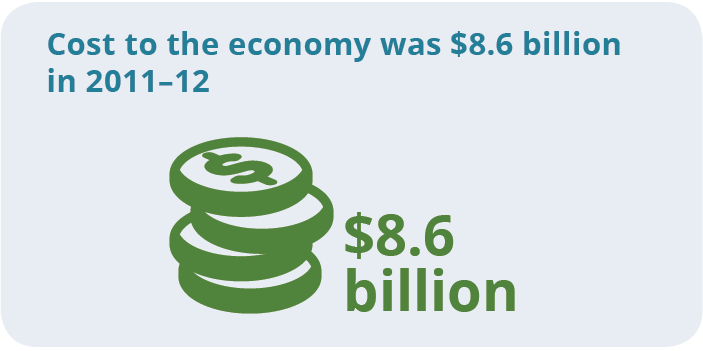
Small changes, big health gains
If all Australians at risk of disease due to overweight or obesity reduced their body mass index by just 1 kilogram per metre squared, or about 3 kilograms for a person of average height, the overall health impact of excess weight would drop substantially. Maintaining any weight loss is critical for long-term health gains.
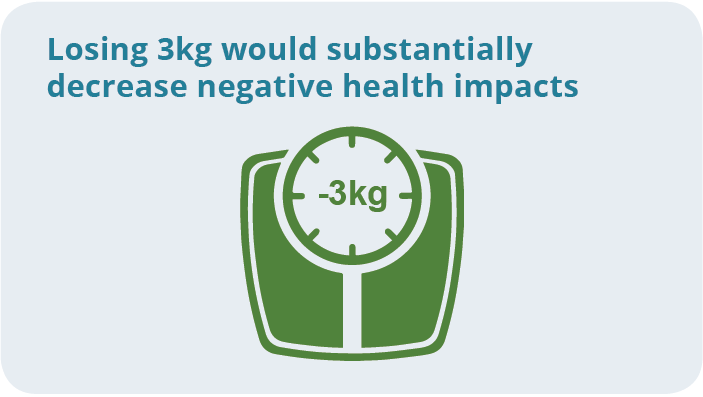
Approaches for reducing overweight and obesity
Population health approaches to address overweight and obesity provide an opportunity for widespread benefit. They include laws and regulations, tax and price interventions, community-based interventions—including those in schools and workplaces—and public education through platforms such as social marketing campaigns.
Individual-level approaches are also important, and may either be preventive, or incorporate treatment strategies such as weight loss surgery.
1. Introduction
- Defining overweight and obesity
- Measuring overweight and obesity in children
- Structure of this report
2. Factors leading to overweight and obesity
- Food and nutrition
- Physical activity
- The obesogenic environment
- Schools
- Workplace
- Home and neighbourhood
- Media influence
- Increase in convenience foods and portion sizes
3. Overweight and obesity among children and adolescents
- Prevalence of overweight and obesity in children and adolescents
- Trends in prevalence
- Prevalence by birth cohort
- Prevalence by remoteness area
- Prevalence by socioeconomic group
- Prevalence among Indigenous children and adults
4. Overweight and obesity among adults
- Prevalence of overweight and obesity in adults
- Body mass index
- Waist circumference
- Trends in prevalence
- Prevalence by birth cohort
- Prevalence by remoteness area
- Prevalence by socioeconomic group
- Prevalence among Indigenous adults
- Prevalence by Primary Health Network area
- International comparisons
- Maternal overweight and obesity
5. Impact of overweight and obesity
- Health impacts
- Chronic conditions
- Mortality
- Burden of disease
- Economic impacts
6. Approaches for reducing overweight and obesity
- Laws and regulations
- Tax and price interventions
- Community-based interventions
- Health promotion
- Weight loss surgery
Appendix A: Classification of overweight and obesity for children and adolescents
Appendix B: Defining socioeconomic groups
Appendix C: Measuring overweight and obesity rates at Primary Health Network area level
Appendix D: State and territory policy actions and infrastructure support actions
End matter: Acknowledgments; Abbreviations; Symbols; Glossary; References; List of tables; List of figures; List of boxes; Related publications



